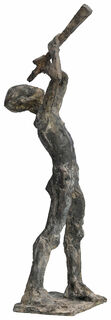Sculpture "Stargazer", bronze
Sculpture "Stargazer", bronze
Quick info
ars mundi Exclusive Edition | limited, 199 copies | numbered | signed | bronze | chased | patinated | size 12 x 40 x 10 cm (w/h/d) | weight approx. 2.5 kg
Detailed description
Sculpture "Stargazer", bronze
Stargazing is the origin of all science, and today, as thousands of years ago, human beings look up at the firmament with fascination. Knuth Seim's "Stargazer" is no exception - armed with a long telescope, he gazes at the glittering firmament. Seim portrays him with almost dramatic body tension: His feet are slightly bent for a secure stand, and his head tilted far back. He seeks to grasp his target.
Seim, born in 1961 in Karl-Marx-Stadt (Chemnitz), returns to his artistic roots with the Stargazer. Since a study visit to Senegal, the trained stonemason and sculptor has mainly worked in a simple, reduced style. But with this sculpture, he once again realises his motif figuratively and realistically.
The figure was originally created as a design for a sculptural group for the Märkischer Platz in the "City of Optics" Rathenow.
Sculpture cast using the Lost-Wax-Process in bronze, chiselled and patinated. Limited edition 199 copies, signed and numbered. Size 12 x 40 x 10 cm (w/h/d). Weight approx. 2,5 kg. Exclusively at ars mundi.
An alloy of copper with other metals (especially with tin) used since ancient times.
When casting bronze, the artist usually applies the lost-wax technique which is dating back more than 5000 years. It's the best, but also the most complex method of producing sculptures.
First, the artist forms a model of his sculpture. It is embedded in a liquid silicone rubber mass. Once the material has solidified, the model is cut out. The liquid wax is poured into the negative mould. After cooling down, the wax cast is removed from the mould, provided with sprues and dipped into ceramic mass. The ceramic mass is hardened in a kiln, whereby the wax flows out (lost mould).
Now we finally have the negative form, into which the 1400° C hot molten bronze is poured. After the bronze had cooled down, the ceramic shell is broken off and the sculpture is revealed.
Now the sprues are removed, the surfaces are polished, patinated and numbered by the artist himself or, to his specifications, by a specialist. Thus, each casting becomes an original work.
For lower-quality bronze castings, the sand casting method is often used which, however, does not achieve the results of a more complex lost-wax technique in terms of surface characteristics and quality.
Graphic or sculpture edition that was initiated by ars mundi and is available only at ars mundi or at distribution partners licensed by ars mundi.
Term for an art object (sculpture, installation), which is produced in multiple copies in a limited and numbered edition according to the artist‘s will.
Artist's multiples have been called the most accessible and affordable art on the market.
A plastic work of sculptural art made of wood, stone, ivory, bronze or other metals.
While sculptures from wood, ivory or stone are made directly from the block of material, in bronze casting a working model is prepared at first. Usually, it is made of clay or other easily mouldable materials.
The prime time of sculpture after the Greek and Roman antiquity was the Renaissance. Impressionism gave a new impulse to the sculptural arts. Contemporary artists such as Jorg Immendorf, Andora, and Markus Lupertz also enriched sculptures with outstanding works.






